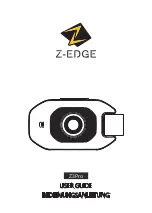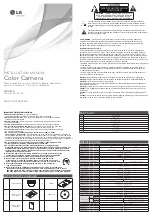
18
Checking the camera
●
Check the thermal imaging camera for structural, heat and
chemical damage.
●
Check the mechanical hardware to ensure no screws are loose
and no gaskets are loose or misplaced.
●
Check all lenses for heat damage, chemical damage, cracks and
breaks.
●
Ensure that all labels are intact.
●
Check the batteries for damage or leakage; especially check the
battery contacts for damage.
●
Check the LEDs for the charger and the thermal imaging camera
for proper indications.
If any damage is found, the thermal imaging camera should be
removed from service immediately and returned for service or repair
to a Service Center. After using the thermal imaging camera, we
recommend that the battery be recharged using the desk top charger
and that it be left in the charger when not in use.
This will not harm the battery.
Regular Inspections
We recommend to perform the following procedure regularly if the
camera is stored and not used.
●
Remove the thermal imaging camera from the case and check for
visible damages or defects to the camera's surface.
●
If signs of contamination or if mold is found, clean the thermal
imaging camera.
●
Check that the thermal imaging camera is working properly:
Insert battery and turn the thermal imaging camera on.
The thermal image must be shown and the buttons must function.
Then switch the thermal imaging camera off and remove the
battery.
●
Blow debris out from the battery rails and from the battery latch.
●
Recharge the batteries (see “Rechargeable batteries” on
page 11).
●
Store the thermal imaging camera (see “Storage” on page 24).
●
Charge the battery every four months to prevent over-discharge.
●
Dispose of the battery when the battery runtime is no longer
sufficient.
The following procedure will allow the battery to show its exact
capacity. Perform this procedure every 3 to 6 months:
●
Fully charge the battery.
●
Switch on the thermal imaging camera and allow it to run without
interruption at room temperature until it automatically shuts down.
●
Fully charge the battery again.
Now it is ready for use.
Dräger offers a full inspection of the thermal imaging camera
including a function test on request. For details please contact
Dräger Safety.
Summary of Contents for UCF 1600
Page 2: ......
Page 295: ...295...
Page 346: ...346 360 361 Dr ger Safety 1334 2000 E Dr ger Safety IP67...
Page 348: ...348 flashover UCF1600 3200 Dr ger Li Ion D Dr ger Safety...
Page 349: ...349 Dr ger Safety 0 o...
Page 351: ...351 18 19 20 21 ThermalScan CP 01 CP 02 CP 06 356 23 Li Ion SHUTDOWN 10 80 60 40 20 Shutdown...
Page 352: ...352 24 oC oF 20 10 ThermalScan 21 oC oF Dr ger Safety Lithium Ion 4 22 oC 72 oF...
Page 354: ...354 LED D...
Page 358: ...358 FM Video Dr ger Safety 1 LED 1 2 2 LED 2 LED SD USB PC USB 15...
Page 360: ...360 n LED...
Page 361: ...361 360 360 3 6 Dr ger Dr ger Safety...
Page 362: ...362 ON OFF Dr ger Safety ON OFF LED 5 LCD Dr ger Safety Dr ger Safety...
Page 363: ...363 Dr ger Safety LED 0 oC 35 oC 32 oF 95 oF LED...
Page 364: ...364 Dr ger Safety Dr ger Safety 60 cm Dr ger Safety Dr ger Safety Dr ger Safety PC...
Page 365: ...365 LED 1 PC USB USB LED 2 Dr ger Safety LED 1 LED 2 USB...
Page 366: ...366 LED In Line LED LED z B WD 40...
Page 371: ...371...
Page 372: ...372...
Page 373: ...373...
Page 375: ......
















































